The Highway Code
Table of Contents
Part 3 - Motorists and Motor Cyclist
Part 4 - Other Road Users and Animals
SIGNS AND SIGNALS
Part 3 - MOTORISTS AND MOTOR CYCLISTS
- All vehicles must be registered with the Licensing Authority.
- Before you drive make sure that your vehicle is licensed and insured.
- Keep your vehicles in good condition. Pay attention to lights, horn, brakes, steering, tyres (including spares), windscreen wipers and washers. Keep wind screens, head lamps, indicators, reflectors, mirrors and number plates clean and clear.
- Before moving off, look in your rear view mirror, and around to make sure it is clear behind and that nothing is about to overtake. Give a right turn signal and move off when it is safe to do so.
- Keep to the left, except when overtaking, or when passing stationary vehicles or for other reasonable or sufficient cause.
- Use your rear view mirror often so that you know what is behind you. Do not stare at it, glance in it.
- Always keep a special lookout for pedal cycles and motor cycles, particularly when overtaking or turning. Bear in mind that two wheelers are much less easy to see than larger vehicles.
- Do not exceed speed limits for the road and for your vehicle. Remember that any speed limit is a maximum. It does not mean that it is always safe to drive at that speed. Always take into consideration the conditions of the road. The speed limit in a built up area is 50 km/h and outside a build up area is 80 km/h.
- Never drive at such speed that you cannot stop well within the distance you can see to be clear. Go much slower it the road is wet.
- Always keep a safe distance behind the vehicle in front of you, so you can stop if it slows down or stops suddenly. The safe rule is never to get closer than the overall stopping distance as shown as follows.
SHORTEST STOPPING DISTANCES
| km/h | Reaction distance Metres | Braking distance Metres | Overall stopping distance metres |
On a dry road, a good car with good brakes and tyres and an alert driver, will stop in the distance shown. Remember these are shortest stopping distances. Stopping distances increase greatly with wet and slippery roads, poor brakes and tyres, and tired drivers. |
| 30 | 6 | 6 | 12 | |
| 50 | 9 | 13 | 22 | |
| 60 | 12 | 25 | 37 | |
| 80 | 15 | 38 | 53 | |
| 100 | 18 | 54 | 72 |
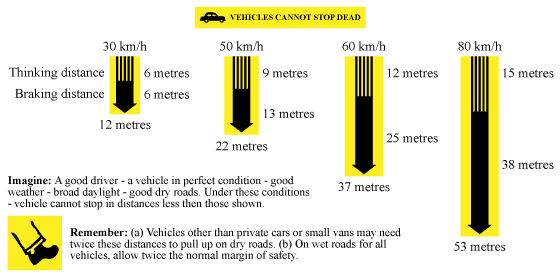
- Pull on the left side of the road, stop and allow the passage of ambulances, fire engines, protective service vehicles or other emergency vehicles when they are sounding horns or sirens or displaying flashing or swivelling lights. Do not chase behind emergency vehicles in an effort to get ahead of traffic.
- Driving for a long time may make you feel sleepy. To help prevent this, make sure there is plenty of fresh air in your vehicle. If you become tired, stop and rest at a suitable parking place.
- When Towing another vehicle the Tow rope or draw-bar must not exceed five metres.
- Where there is a double white line along the middle of the road, note whether the one nearer to you is continuous or broken and observe these rules:-
- If both lines are continuous or the line nearer to you is continuous, keep on the left of it and do not cross or straddle the line(s).
- If the line nearer to you is broken, you may cross it, but only do so if you can complete your overtaking safely and before reaching a continuous white line on your side. See Figure (4).
- Never cross a single broken white line along the middle of the road unless it is safe to do so.
- Never cross a single continuous white line along the middle of the road.

Figure 4

Figure 5
- Keep with the lane markings and cross them only when moving into another lane. You should change lanes only when you have given the appropriate signal and it is safe to perform the manoeuvre. Slow moving traffic should always keep on the left lane. Se Figure (5).
- In traffic hold-ups or slow moving traffic do not jump the queue.
- Well before you reach a junction, make sure you are in the appropriate lane.
- When a vehicle is involved in an accident whereby injury or damage is caused to any person, animal or property the driver of such vehicle shall immediately stop and convey or cause to be conveyed any injured person to a doctor or hospital, give his name and address and Driving Permit particulars to interested parties and immediately report the accident to a Police Officer or the nearest Police Station. It is advisable to mark the position of the wheels of the vehicle(s) involved, in the presence of a witness.
- Drive carefully and slowly when pedestrians are about, particularly in crowded shopping streets. When you are approaching a stationary bus or other stationary vehicle, watch out for pedestrians emerging suddenly from behind it.
- At pedestrian crossings controlled by the light signals, give way to pedestrians who are crossing when the signal facing you i,s red.
- When turning at a road junction, give way to pedestrians who are crossing the road into which you are turning.
- When entering or emerging from a private road or property, give way to pedestrians as well as traffic on the public road.
- Slow down when pedestrians, processions or other marching groups are in the road, particularly where there is no footpath. Give them plenty of room and be extremely cautious.
- When coming to a zebra crossing, keep a look out for pedestrians waiting to cross (particularly children, the elderly, or the infirm).
- Go slowly when driving past animals. Give them plenty of room and be ready to stop if necessary. Do not frighten the animals by sounding your horn or reviving your engine.
- When a horse or other animal is being led, or ridden you must stop if signalled to do so by the person in charge.
- When approaching a junction with a sign marked “Stop” and a white line at the corner, you are to slow down gradually and stop before the white line. Proceed only when the major road is clear. See Figure (8) on page 15.
- At a junction look right, then left, then right again. Do not go until you are sure that it is safe to do so. Do not assume that the vehicle approaching from the right which is signalling with its left hand indicator will turn left. Wait to make sure.
- Well before you turn right at a junction, look in your rear view mirror to make sure that nothing is about to overtake. When it is safe, make a right turn signal and take up a position just left of the middle of the road with wheel pointing straight leaving room for vehicles from behind to overtake on the left. Wait until it is clear in front then turn.
- If you intend to turn left, keep on the left, make a left turn signal in good time, and do not swing out to the right either before or after making the turn.
- When crossing a dual carriage-way or turning right into one, treat each half as a separate road. Wait in the central dividing strip (between the two traffic islands) until there is a safe gap in the traffic on the second half of the road. However, where the central reserve is too narrow for the length of your vehicle, you should wait in the side road until you can cross the dual carriage-way in one movement.
- At police controlled junctions let the police officer know clearly by your signal which way you want to go. Do not filter left when straight ahead traffic is held up unless you receive a signal to do so.
- When a junction is controlled by traffic lights do not go forward when the light is green unless there is room for you to clear the junction completely. Never go forward when the red and amber lights are showing together.
- Where there is green arrow filter signal at junctions controlled by the traffic lights, do not enter the filter lane unless you intend to go in the direction shown by the arrow.
- When approaching flashing traffic signals, the following should be observed:
- A flashing red signal means that you must stop and proceed when it is safe to do so
- A flashing amber signal means that you must slow down and proceed with caution.
- A flashing green signal means that you must slow down and, if turning, give way to opposing traffic.
- A green signal with an amber arrow means that you should slow down and if turning, give right–of-way to opposing traffic.
- At traffic lights, vehicles required to “Stop” must wait behind the solid white “Stop” line marked across the approach.
- At a roundabout you will see a sign indicating “Roundabout”. The vehicles on the right have the right-of-way. Do not overtake or stop to put down or take up passengers at a roundabout.
- Before you reverse make sure that there are no pedestrians or obstructions behind you.
- Do not reverse from a side road into a main road.
- If your view is restricted, get help before reversing.
- It is illegal to reverse at a junction, or around a corner
- You must make sure that all your lamps are clean, that they work and that your headlamps are properly adjusted – badly adjusted lamps can dazzle road users and lead to accidents. See Figure (6).
- At night always drive well within the limit of your lights.
- In built-up areas use dipped headlights.
- On unlighted roads always use your bright headlights. When meeting other vehicles dip them. If you are dazzled, slow down or stop. See figure (7).
- Drive on dip headlights when driving behind another vehicle.
- In daytime whenever visibility is poor, switch on your park or dim lights to enable other road users to see you clearly.
- Flashing amber hazard lights have only one meaning – like sounding your horn, it lets other road users know you are there and in distress.It is an offence to use them for any other purpose, e.g., Driving, Parking, in Inclement Weather, etc.
- It is an offence to sound your horn unnecessarily at weddings, near a hospital, to attract the attention of persons or to hasten drivers on the green light. It is also illegal to sound horns between the hours of 9.00 p.m. to 5.30 a.m. in the City of Port-of-Spain, the Boroughs of San Fernando and Arima.
- Before overtaking consider if it is necessary. To overtake look in your rear view mirror, make sure that nothing is about to overtake you and see that the road ahead is clear.
“Clear means that there is no vehicle approaching from in front; that there are no parked vehicles or road repairs in front of the vehicle that you are about to overtake; that the vehicle in front is not itself overtaking and that there is sufficient space on the left to get back in lane after overtaking. Make a right turn signal. Sound your horn, observe the vehicle in front. When you have sufficient space to overtake, you do so on the right, then travel about three to four car lengths and get back to the left side do not cut in on the vehicle you are overtaking.

Figure 8
- Do not Overtake:
- Around a corner or bend.
- At the brow of a hill.
- On a hump-back bridge.
- So that you force another vehicle to swerve or come to a sudden stop.
- In a pedestrian crossing zone
- If you cannot see far enough ahead.
- At an intersection.
- At no passing zones.
IF IN DOUBT, DO NOT OVERTAKE.
- Do not Park or Wait:
- On a hump back bridge.
- At or near a road junction or bend.
- At the brow of a hill (as others will be unable to see what may be approaching).
- On a footpath or cycle track.
- Opposite or nearly opposite another standing vehicle or other obstructions (e.g., road repairs, etc.).
- Alongside a standing vehicle.
- At a bus Stop, private entrances (e.g., School, Cinema, Hospital).
- On a dual carriageway do not park on the right side of the left carriageway.Park only on the extreme left of the carriageway provided there is no other restriction.
- Within 3 metres of a fire hydrant of the frontage of a Fire Station.
- Within 9 metres of a corner.
- So as to obstruct the free movement of vehicles in a Car Park.
- On a Pedestrian Crossing Zone.
- When you draw up, pull as close as possible to the edge of the road. On a highway pull on to the shoulder of the road.
- It is illegal for a vehicle to be parked at night in the city of Port-of-Spain, or the Boroughs of Arima and San Fernando without lights, unless there is painted on the rear of the vehicle and on the right or off-side thereof (on or near as possible to the read off-side mudguard) a white rectangle or circle at least 320 square centimetres in area so as to face, and be visible to, traffic approaching from the rear. You may park without lights at a place appointed solely for parking.
- When there is a breakdown, get your vehicle off the road if possible and take the requisite steps to indicate its presence and position by lighting or otherwise to other persons using the road. If you cannot remove it off the road take immediate steps to have it removed as near to the left as possible. See Figure (9).
- To drive a taxi you must be the holder of a Taxi Driver’s Badge and Licence. Being the holder of a Class 3 Driving Permit and owning a taxi, does not qualify you to drive a taxi, not even in a case of emergency.
- Number plates must be affixed one to the front (not inside) and the other to the back of the Motor vehicle or trailer and in an upright position and must be easily distinguishable. Failing to comply you are liable to a fine of $1,000.00 or 6 months imprisonment, M.V.R.T.R. 9 and M.V.R.T.A., section 91(1) 48:50.
LANE MARKINGS
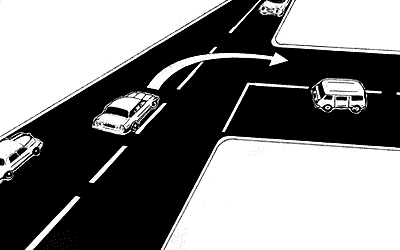
Remember the driver on each vehicle has a “Blind Spot” in his vision with respect to vehicles overtaking on either side be extra careful.

Figure 6

Figure 7
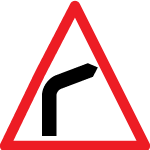
Dangerous Bend
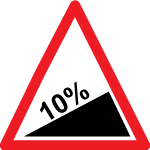
Steep Ascend
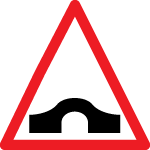
Hump Bridge
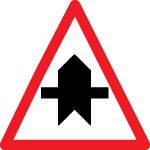
Intersection
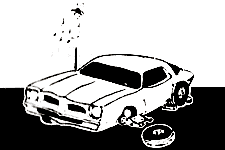
Tie a white cloth to your radio antenna, door handle, or some other place where it may be easily seen. If you do not have a white cloth, raise your bonnet.

Figure 9










